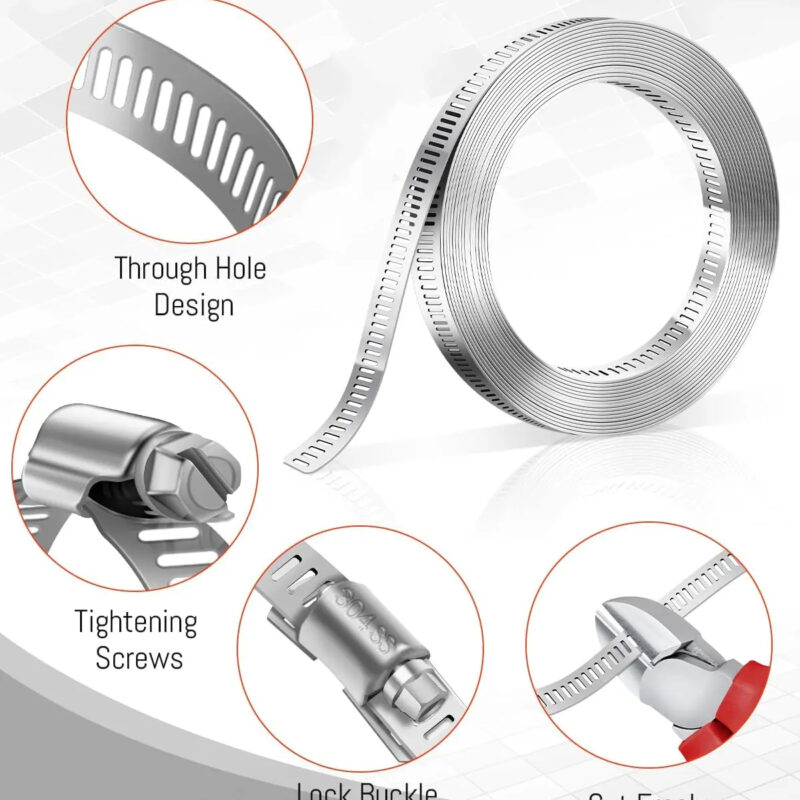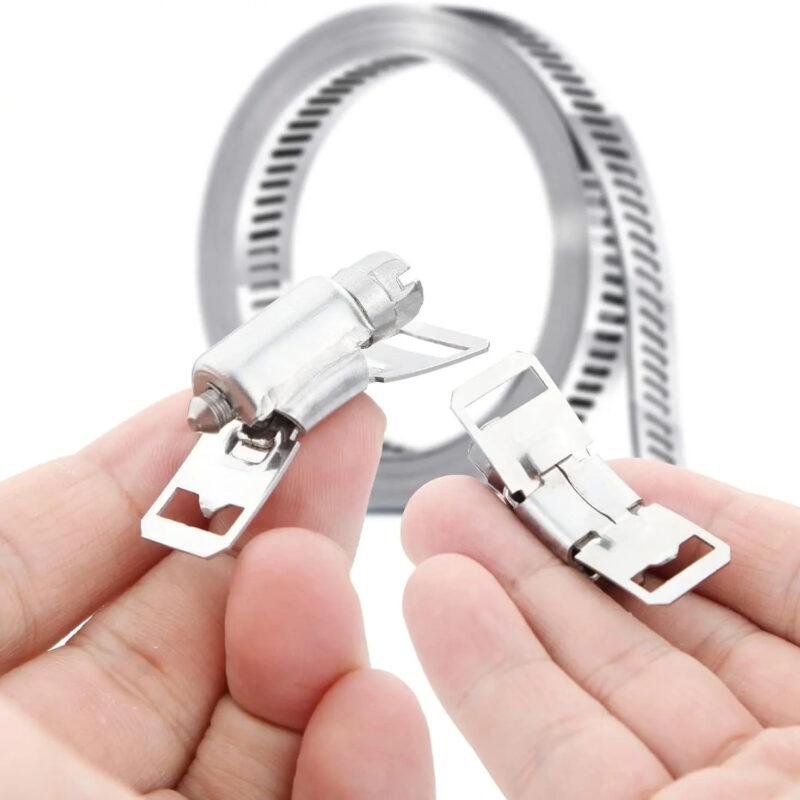Stainless steel American hose clamp
A stainless steel American hose clamp is a kind of hardware fitting made of stainless steel. It consists of a steel band with a bolt and nut. It’s used to firmly fix hoses in various industries like automotive, marine, industrial equipment, and construction by tightening the bolt to prevent hose disconnection or leakage, with features of corrosion resistance and different specifications for various applications.
Description
Structural features
Main material: Made of stainless steel, it has excellent corrosion resistance, can be used for a long time under different environmental conditions, is not easy to rust, and effectively extends the service life. Common stainless steel materials include 304, 316, etc. Among them, 316 stainless steel has stronger corrosion resistance and is suitable for more severe working environments.
Clamping design: It is generally composed of a steel belt with bolts and nuts. The steel belt usually has a certain elasticity and strength and can fit tightly on the surface of the hose. By tightening the bolts and nuts, the steel belt is tightened, thereby firmly fixing the hose to prevent the hose from falling off or loosening.
Ear design: Ears are usually provided at both ends of the hose clamp, and there are holes for the bolts to pass through. This design facilitates installation and disassembly, and also enhances the connection stability between the hose clamp and the hose.
Specifications and dimensions
Diameter range: The diameter of stainless steel American hose clamps is widely applicable, ranging from a few millimeters to tens of millimeters, such as 6mm, 8mm, 10mm, 12mm, 16mm, 20mm, 25mm, etc., which can meet the fixing needs of hoses of different diameters.
Steel belt width: The width of the steel belt is also diverse, generally with different specifications such as 6mm, 8mm, 10mm, 12mm, etc. Wider steel belts can provide greater clamping force and contact area, suitable for occasions with higher fixing requirements; while narrower steel belts are relatively more flexible and suitable for some installation locations with limited space.
Bolt specifications: The specifications of the bolts usually match the overall size of the hose clamp, and common ones are M4, M5, M6, M8, etc. The length of the bolts will also vary according to different pipe diameters and installation requirements to ensure that the hose can be firmly clamped.
Application areas
Automotive industry: used for the connection and fixation of pipelines such as the cooling system, fuel system, and intake system of automobile engines. For example, installing stainless steel American hose clamps on the cooling water pipeline can prevent coolant leakage and ensure the normal operation of the engine.
Shipbuilding: Stainless steel American hose clamps are widely used in various piping systems of ships, such as seawater cooling systems, fresh water supply systems, fuel delivery systems, etc. Its corrosion resistance can resist the erosion of seawater and humid environments, ensuring the safety and reliability of ship pipelines.
Industrial equipment: It is used to fix connecting hoses in hydraulic systems, pneumatic systems, lubrication systems, etc. of various industrial equipment. For example, on the automated production line of a factory, hydraulic and pneumatic pipelines are fixed by stainless steel American hose clamps to ensure the normal operation and production efficiency of the equipment.
Construction industry: Stainless steel American hose clamps are also used in the water supply and drainage system and HVAC system of the building. For example, installing hose clamps on the refrigerant pipeline of the air conditioner can prevent refrigerant leakage and improve the operating efficiency and stability of the air conditioning system.
Installation method
First, insert the hose into the pipe or equipment interface to be connected, ensure that the insertion depth is appropriate, and then put the stainless steel American hose clamp on the hose so that the center position of the hose clamp is aligned with the connection part.
Next, pass the bolt through the ear hole of the hose clamp and screw on the nut, but do not tighten it.
Finally, use a tool to gradually tighten the nut to tighten the steel belt and firmly fix the hose to the pipe or equipment. During the tightening process, pay attention to even force to avoid deformation of the hose clamp or damage to the hose due to uneven force.
Selection points
Diameter matching: Select a hose clamp of appropriate diameter according to the outer diameter of the hose to be fixed, and ensure that the hose clamp can fit tightly on the surface of the hose and provide sufficient clamping force. Generally speaking, the inner diameter of the hose clamp should be slightly smaller than the outer diameter of the hose to ensure the fixing effect.
Working pressure: Consider the working pressure that the hose is subjected to and select a hose clamp that can meet the pressure requirements. If the working pressure is high, a hose clamp with higher strength and greater clamping force should be selected to prevent the hose from falling off or leaking under pressure.
Working environment: Select a stainless steel hose clamp of suitable material according to the different use environments. For example, in a highly corrosive environment, a hose clamp made of 316 stainless steel should be preferred; in a general environment, a hose clamp made of 304 stainless steel can meet the requirements.
Installation space: Pay attention to the size of the space at the installation location and choose a hose clamp with the appropriate width and length. If space is limited, choose a hose clamp with a smaller size and compact structure to ensure smooth installation.
Additional information
| Weight | 0.01 kg |
|---|---|
| Dimensions | 30 × 30 × 30 cm |
| Materials | Iron and stainless steel |
| Material Type | Metal |
| Product name | American hose clamp |













